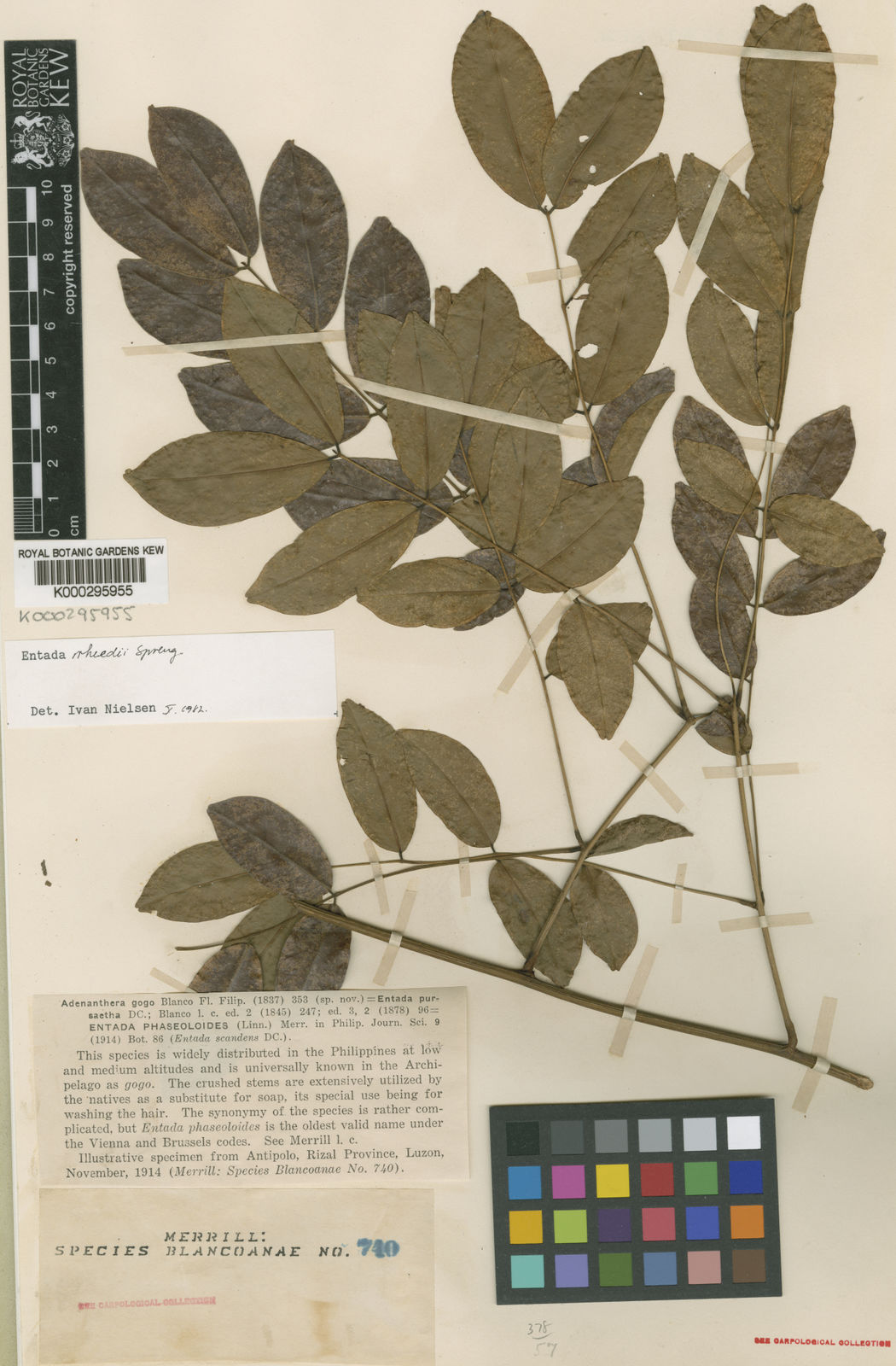Stinking Toe
entada phaseoloides
Also known as: ["Stinking Toe","Sea Bean","Tropical Bean"]
Overview
A large, woody vine or liana native to tropical regions, known for its large, woody seed pods and pungent-smelling edible pulp.
Benefits & Perks
["edible fruits","wildlife attractant (bees, butterflies, birds)"]
Botanical Classification
| Phylum: | Magnoliophyta |
| Class: | Magnoliopsida |
| Order: | Fabales |
| Family: | Fabaceae |
| Genus: | Entada |
| Botanical Name: | Entada phaseoloides |
Plant Characteristics
Basic Information
- Category: Shrubs
- Suitable Location: tropical garden, trellis, or large container
- Suitable For:
- Is Weed: No
- Allergenicity: low
Environmental Needs
- Climate: {"temperatureRange":"20–35°C"}
- Hardiness: {"zones":"10–12"}
- Misting: every 2–3 days in dry climates, otherwise rarely required
- Drainage: Fast-draining to prevent waterlogging.
- Soil Type: Well-draining potting mix with added perlite or sand for aeration.
Maintenance Level
- Maintenance Level: moderate
- Toughness Level: moderate
- Pruning Frequency: Annually or as needed to maintain shape and health.
- Pruning Intensity: Moderate; remove up to one-third of growth if necessary.
Care Details
Ideal Sunlight Coverage:
Bright indirect light for 6–8 hours daily; tolerates partial shade but may become leggy.
Sunlight Tolerance Tips:
Acclimate gradually to intense light; protect from direct midday sun to avoid scorching; adjust placement based on indoor/outdoor conditions.
Care Requirements
Care Difficulty
moderatemoderate
Sunlight
partial shade to full sun
Rotate plant for even growth; use sheer curtains to filter intense light; move outdoors in warm months for better light exposure.
Watering
every 7–10 days during active growth, reduce in winter
Water deeply to encourage root growth; allow soil to dry between waterings; avoid overwatering.
Soil
well-draining, loamy soil with organic matter
pH: Slightly acidic to neutral (pH 6.0–7.0).
Ensure pots have drainage holes; avoid heavy clay soils; top-dress with compost annually.
Temperature
Prefers 65–85°F (18–29°C); thrives in warm, humid conditions; sensitive to frost.
Keep away from drafty windows; use a humidifier in dry environments; monitor temperature fluctuations.
Fertilizing
every 4–6 weeks during growing season with balanced liquid fertilizer
Avoid over-fertilizing to prevent salt buildup; flush soil occasionally to remove excess salts; apply fertilizer to moist soil.
Propagation
Methods
Stem cuttings or seed; stem cuttings are more common for home growers.
Step-by-Step Propagation Guide
- Take a 4–6 inch cutting.
- Remove lower leaves.
- Apply rooting hormone.
- Plant in medium.
- Maintain humidity.
Best Time: Spring or early summer when the plant is actively growing.
Environment
High humidity (70–90%), warm temperatures (75–85°F), indirect light.
Medium
Well-draining mix of perlite and peat moss or cactus mix.
Hormone
Rooting hormone is recommended to improve success rates.
Timeline
Roots may develop in 4–8 weeks; establishment can take several months.
Tools Needed
Pruning shears, rooting hormone, small pots, plastic wrap or propagator.
Quick Tips
Use healthy, non-flowering stems; keep soil consistently moist; provide bottom heat for faster rooting.
Pruning & Repotting
Pruning Guide
Method
Selective pruning of stems to encourage branching; avoid cutting into old wood.
Pruning Plan
Shape the plant, remove dead or overgrown stems, and encourage bushier growth.
Tools
Pruning shears, sterilizing solution, gloves.
Checklist
Sterilize tools; prune in early spring; remove dead/damaged growth; shape evenly.
Repotting Guide
Best Season
Spring, before the active growing season begins.
Pot Size
Increase pot size by 2–3 inches in diameter.
Method
Remove plant gently; trim roots if needed; place in a slightly larger pot with fresh soil; water lightly.
Suggestions
Repot every 2–3 years or when roots fill the pot; beneficial for growth and health.
Checklist
Check root bound status; prepare new pot; trim roots; use fresh soil; water lightly.
Advanced Care Tips
Watering Mastery
Watering Checklist
Check soil moisture; water deeply; ensure drainage; adjust for season.
How to Apply Water Properly
Water at the base of the plant, ensuring even saturation of the root zone; allow excess water to drain freely; water in the morning to reduce evaporation.
Watering Schedule Tips
Water thoroughly when the top 1–2 inches of soil are dry; reduce frequency in winter to prevent root rot.
Soil Improvement
Add perlite or coarse sand to improve drainage; incorporate organic matter like compost for fertility.
Temperature Stress Management
Signs of Temperature Issues
Yellowing leaves (cold stress), wilting or leaf drop (heat stress), stunted growth.
Cold Stress
Growth slows or halts; leaves may yellow or drop; risk of root damage in freezing temperatures.
Solution: Move to a warmer location; insulate roots with mulch; avoid cold drafts; protect from frost.
Hot Stress
Wilting, leaf scorch, or leaf drop; reduced vigor; potential for pest infestations.
Solution: Provide shade during peak heat; increase humidity with misting; ensure adequate water; avoid direct sun.
Fertilizing Guide
Fertilizing Checklist
Check season; dilute fertilizer; apply to moist soil; avoid foliage contact.
Fertilizing Method
Use balanced liquid fertilizer diluted to half strength every 4–6 weeks during growing season (spring/summer); reduce or stop in fall/winter.
Common Problems & Solutions
Toxicity Warning
Cats
Slightly ToxicThe seeds of Entada phaseoloides are mildly toxic to cats if ingested, causing gastrointestinal irritation. The toxic effects are generally limited to digestive discomfort, though monitoring is advised.
⚠️ Symptoms:
🌿 Toxic Parts:
⚡ Toxic If:
if eaten
Dogs
Slightly ToxicThe seeds of Entada phaseoloides can cause mild gastrointestinal upset in dogs if ingested. The toxic compounds primarily affect the digestive tract, leading to discomfort but typically not severe systemic effects.
⚠️ Symptoms:
🌿 Toxic Parts:
⚡ Toxic If:
if eaten
Humans
Slightly ToxicThe seeds of Entada phaseoloides contain toxic compounds that can cause gastrointestinal distress and other mild symptoms upon ingestion. The physiological impact is generally limited to the digestive system, though severe cases may require medical attention.
⚠️ Symptoms:
🌿 Toxic Parts:
⚡ Toxic If:
if eaten
Frequently Asked Questions
Q: Is the fruit of Entada phaseoloides edible?
A: Yes, the pulp inside the large seed pods is edible and is often used in traditional cuisine, though it has a strong, pungent odor.
Q: Does Entada phaseoloides require a lot of maintenance?
A: It requires moderate maintenance, including regular watering and support for its climbing habit.
Q: Is Entada phaseoloides toxic to pets?
A: There is insufficient data on its toxicity to pets; it is recommended to keep pets away from the plant until more research is available.
Quick Reference
| Family: | Fabaceae |
| Care: | moderate |
| Light: | partial shade to full sun |
| Water: | every 7–10 days during activ |
Get Expert Care Tips
Download the Plantious app for personalized care reminders and plant identification!
Google Play App Store








